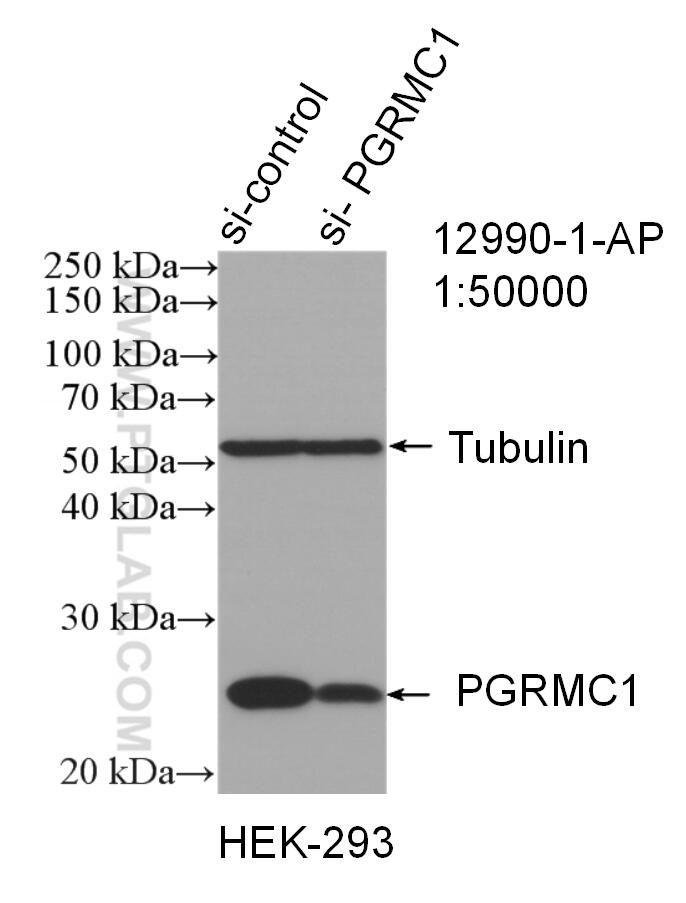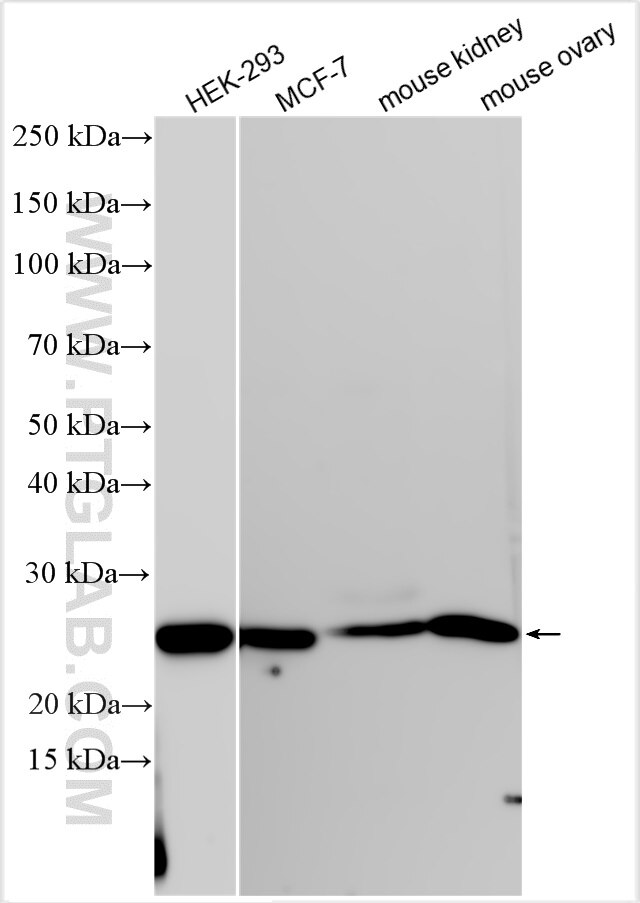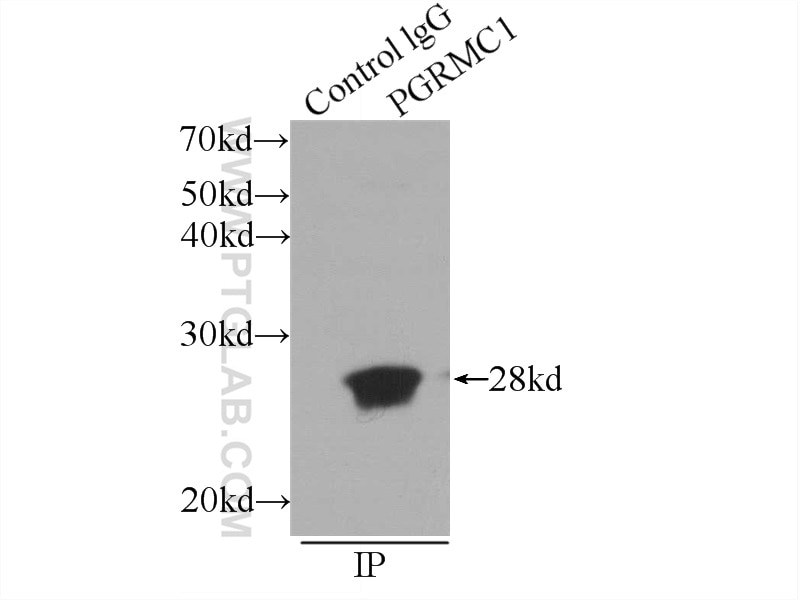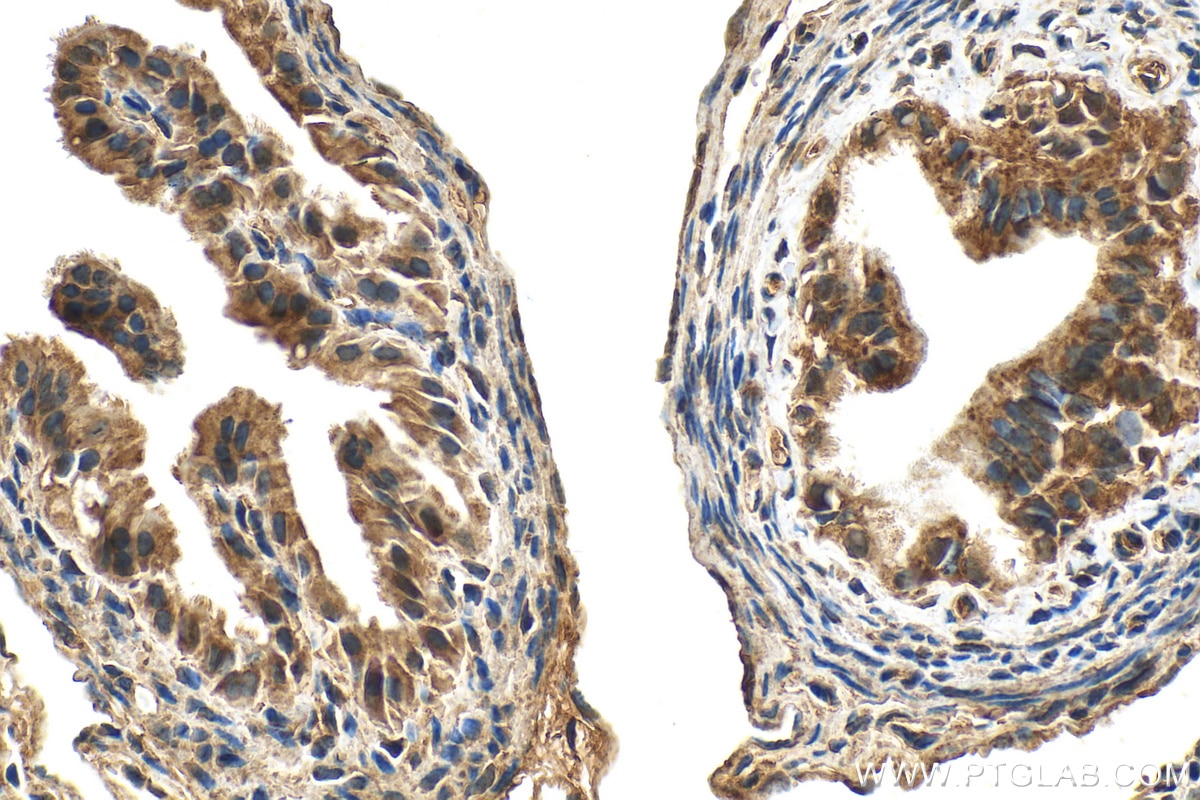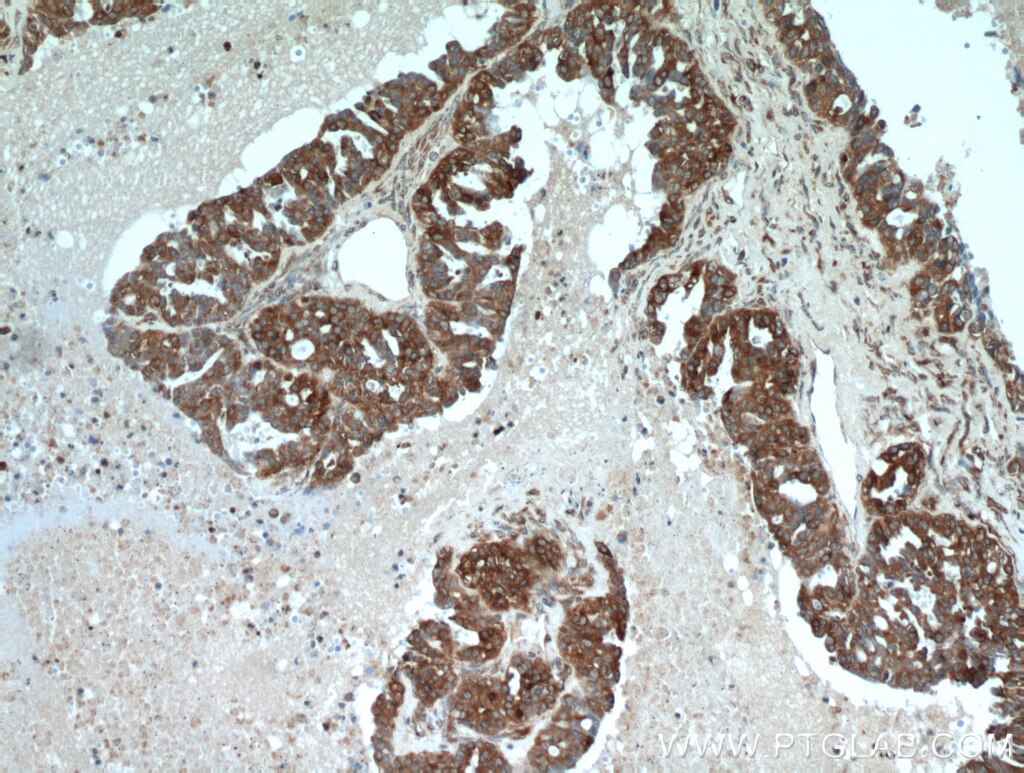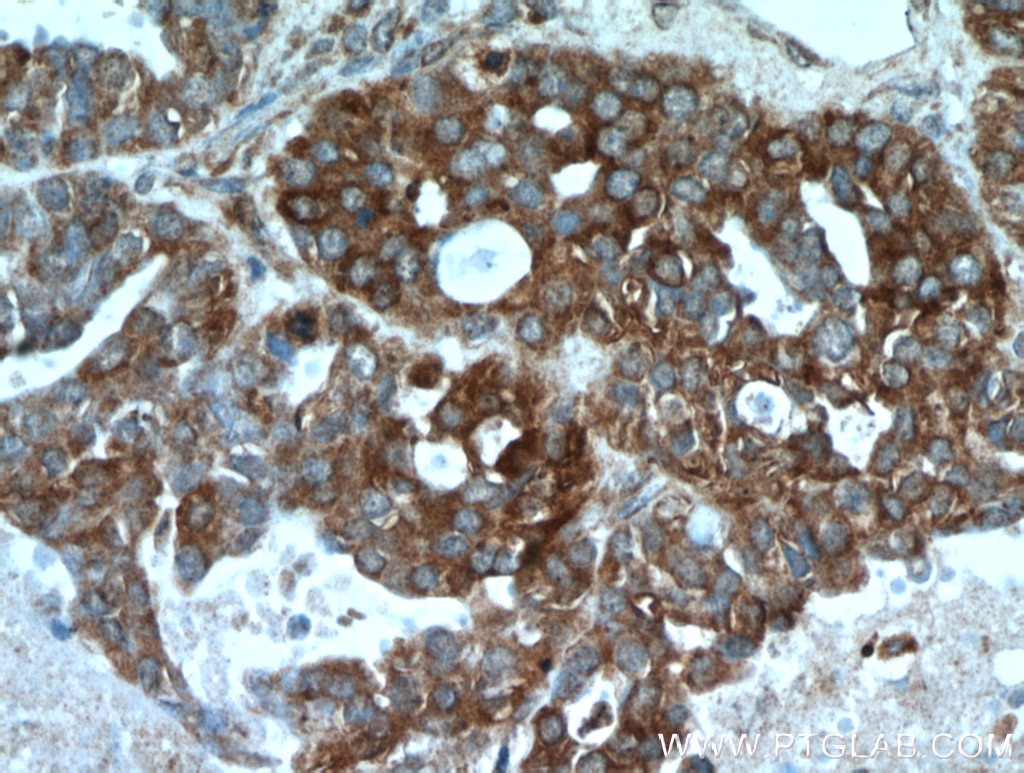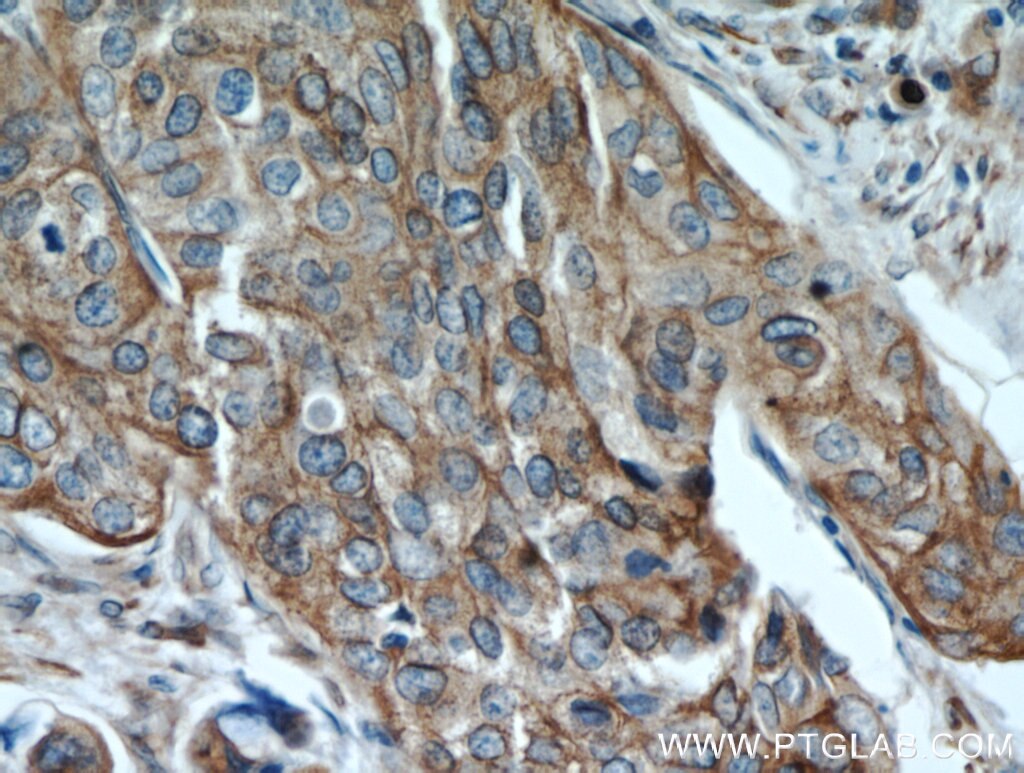Tested Applications
| Positive WB detected in | HEK-293 cells, mouse liver tissue, HepG2 cells, MCF-7 cells, mouse kidney tissue, mouse ovary tissue |
| Positive IP detected in | MCF-7 cells |
| Positive IHC detected in | human cervical cancer tissue, human lung cancer tissue, human ovary tumor tissue, mouse kidney tissue, mouse ovary tissue Note: suggested antigen retrieval with TE buffer pH 9.0; (*) Alternatively, antigen retrieval may be performed with citrate buffer pH 6.0 |
| Positive IF/ICC detected in | HEK-293 cells |
Recommended dilution
| Application | Dilution |
|---|---|
| Western Blot (WB) | WB : 1:2000-1:12000 |
| Immunoprecipitation (IP) | IP : 0.5-4.0 ug for 1.0-3.0 mg of total protein lysate |
| Immunohistochemistry (IHC) | IHC : 1:50-1:500 |
| Immunofluorescence (IF)/ICC | IF/ICC : 1:200-1:800 |
| It is recommended that this reagent should be titrated in each testing system to obtain optimal results. | |
| Sample-dependent, Check data in validation data gallery. | |
Published Applications
| KD/KO | See 7 publications below |
| WB | See 19 publications below |
| IHC | See 4 publications below |
| IF | See 3 publications below |
Product Information
12990-1-AP targets PGRMC1 in WB, IHC, IF/ICC, IP, ELISA applications and shows reactivity with human, mouse, rat samples.
| Tested Reactivity | human, mouse, rat |
| Cited Reactivity | human, mouse, rat, bovine |
| Host / Isotype | Rabbit / IgG |
| Class | Polyclonal |
| Type | Antibody |
| Immunogen |
CatNo: Ag3643 Product name: Recombinant human PGRMC1 protein Source: e coli.-derived, PGEX-4T Tag: GST Domain: 43-195 aa of BC034238 Sequence: YKIVRGDQPAASGDSDDDEPPPLPRLKRRDFTPAELRRFDGVQDPRILMAINGKVFDVTKGRKFYGPEGPYGVFAGRDASRGLATFCLDKEALKDEYDDLSDLTAAQQETLSDWESQFTFKYHHVGKLLKEGEEPTVYSDEEEPKDESARKND Predict reactive species |
| Full Name | progesterone receptor membrane component 1 |
| Calculated Molecular Weight | 195 aa, 22 kDa |
| Observed Molecular Weight | 22-28 kDa |
| GenBank Accession Number | BC034238 |
| Gene Symbol | PGRMC1 |
| Gene ID (NCBI) | 10857 |
| RRID | AB_2164342 |
| Conjugate | Unconjugated |
| Form | Liquid |
| Purification Method | Antigen affinity purification |
| UNIPROT ID | O00264 |
| Storage Buffer | PBS with 0.02% sodium azide and 50% glycerol, pH 7.3. |
| Storage Conditions | Store at -20°C. Stable for one year after shipment. Aliquoting is unnecessary for -20oC storage. 20ul sizes contain 0.1% BSA. |
Background Information
Progesterone receptor membrane component 1 (PGRMC1) is a member of a multi-protein progesterone-binding complex. However, PGRMC1 shares homology with cytochrome b5-related proteins rather than hormone receptors (PMID: 18992768). It is a heme binding protein with biding sites for Src homology (SH2) and SH3 domain-containing proteins (PMID: 17583495). PGRMC1 is overexpressed in a variety of cancers, and thus represents an important biomarker for cancer progression and a potential target for anticancer drugs (PMID: 21730960). In nonmalignant tissues, PGRMC1 is highly expressed in the liver and kidney (PMID: 9705155; 20164297).
Protocols
| Product Specific Protocols | |
|---|---|
| IF protocol for PGRMC1 antibody 12990-1-AP | Download protocol |
| IHC protocol for PGRMC1 antibody 12990-1-AP | Download protocol |
| IP protocol for PGRMC1 antibody 12990-1-AP | Download protocol |
| WB protocol for PGRMC1 antibody 12990-1-AP | Download protocol |
| Standard Protocols | |
|---|---|
| Click here to view our Standard Protocols |
Publications
| Species | Application | Title |
|---|---|---|
EBioMedicine The Sigma-2 Receptor and Progesterone Receptor Membrane Component 1 are Different Binding Sites Derived From Independent Genes.
| ||
Int J Cancer Elevated progesterone receptor membrane component 1/sigma-2 receptor levels in lung tumors and plasma from lung cancer patients. | ||
Transl Psychiatry A potential mechanism underlying atypical antipsychotics-induced lipid disturbances. | ||
Front Pharmacol A Potential Mechanism Underlying the Therapeutic Effects of Progesterone and Allopregnanolone on Ketamine-Induced Cognitive Deficits. | ||
Biol Reprod Hyaluronic Acid Promotes the Expression of Progesterone Receptor Membrane Component 1 via Epigenetic Silencing of miR-139-5p in Granulosa Cells. | ||
J Cell Sci Topology surveillance of the lanosterol demethylase CYP51A1 by Signal Peptide Peptidase |

